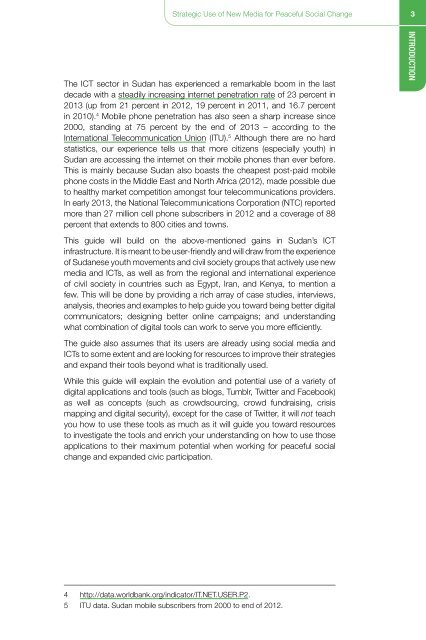Strategic Use New Media Peaceful Social Change
1Uy7LZ0
1Uy7LZ0
You also want an ePaper? Increase the reach of your titles
YUMPU automatically turns print PDFs into web optimized ePapers that Google loves.
<strong>Strategic</strong> <strong>Use</strong> of <strong>New</strong> <strong>Media</strong> for <strong>Peaceful</strong> <strong>Social</strong> <strong>Change</strong> 3<br />
The ICT sector in Sudan has experienced a remarkable boom in the last<br />
decade with a steadily increasing internet penetration rate of 23 percent in<br />
2013 (up from 21 percent in 2012, 19 percent in 2011, and 16.7 percent<br />
in 2010). 4 Mobile phone penetration has also seen a sharp increase since<br />
2000, standing at 75 percent by the end of 2013 – according to the<br />
International Telecommunication Union (ITU). 5 Although there are no hard<br />
statistics, our experience tells us that more citizens (especially youth) in<br />
Sudan are accessing the internet on their mobile phones than ever before.<br />
This is mainly because Sudan also boasts the cheapest post-paid mobile<br />
phone costs in the Middle East and North Africa (2012), made possible due<br />
to healthy market competition amongst four telecommunications providers.<br />
In early 2013, the National Telecommunications Corporation (NTC) reported<br />
more than 27 million cell phone subscribers in 2012 and a coverage of 88<br />
percent that extends to 800 cities and towns.<br />
This guide will build on the above-mentioned gains in Sudan’s ICT<br />
infrastructure. It is meant to be user-friendly and will draw from the experience<br />
of Sudanese youth movements and civil society groups that actively use new<br />
media and ICTs, as well as from the regional and international experience<br />
of civil society in countries such as Egypt, Iran, and Kenya, to mention a<br />
few. This will be done by providing a rich array of case studies, interviews,<br />
analysis, theories and examples to help guide you toward being better digital<br />
communicators; designing better online campaigns; and understanding<br />
what combination of digital tools can work to serve you more efficiently.<br />
The guide also assumes that its users are already using social media and<br />
ICTs to some extent and are looking for resources to improve their strategies<br />
and expand their tools beyond what is traditionally used.<br />
While this guide will explain the evolution and potential use of a variety of<br />
digital applications and tools (such as blogs, Tumblr, Twitter and Facebook)<br />
as well as concepts (such as crowdsourcing, crowd fundraising, crisis<br />
mapping and digital security), except for the case of Twitter, it will not teach<br />
you how to use these tools as much as it will guide you toward resources<br />
to investigate the tools and enrich your understanding on how to use those<br />
applications to their maximum potential when working for peaceful social<br />
change and expanded civic participation.<br />
INTRODUCTION<br />
4 http://data.worldbank.org/indicator/IT.NET.USER.P2.<br />
5 ITU data. Sudan mobile subscribers from 2000 to end of 2012.


